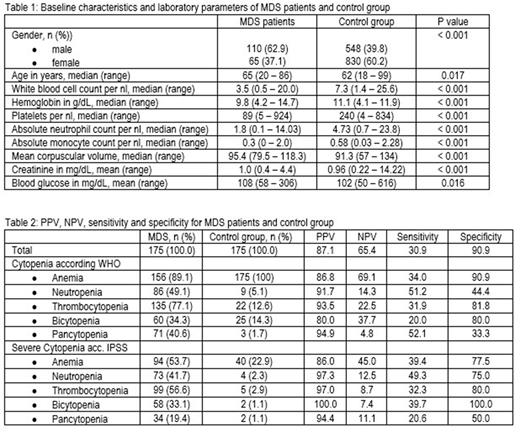Abstract
Introduction: MDS diagnosis requires bone marrow aspiration and core biopsy to analyze cytomorphology, histopathology and genetics. Since the median age at time of diagnosis is approximately 75 years, associated with an increased likelihood of comorbidities, most MDS patients are likely to prefer non-invasive diagnostics over invasive bone marrow biopsy. Recently, Oster et al. published a predictive algorithm to aid in diagnosing or ruling-out MDS. This algorithm is based on Gradient-boosted models (GBMs) using the patients’ gender and age as well as eight laboratory parameters to assess the probability of having an MDS or not. These eight parameters are white blood cell count, hemoglobin level, platelet count, mean corpuscular volume, absolute neutrophil count, absolute monocyte count, as well as creatinine and blood glucose. Depending on the calculated GBM score, patients were categorized as "probably having an MDS” (pMDS), "probably not having an MDS” (pnMDS) or as "indeterminate". The authors used data of 502 MDS patients from the European low risk MDS registry and compared them to a control group of 502 patients resulting in the accurate prediction and exclusion of MDS in 86% of the patients. To facilitate and improve the diagnostic approach to patients with suspected MDS, we aimed to validate the Web-based calculator by applying it to an independent cohort of 175 patients with a diagnosis of MDS as well as a control cohort of 1378 patients without MDS.
Patients and methods: We used data of 175 anemic MDS patients from our Düsseldorf MDS Registry and calculated their GBM score using the web-based app. The control group consisted of 1378 randomly selected patients of the university hospital in Düsseldorf whose laboratory tests were triggered by non-hematologic indications. The only requirement was that patients were anemic (according to WHO definition) and not known to have MDS as the underlying cause. Information about MDS patients and controls are shown in table 1. To calculate positive predictive values (PPVs) and negative predictive values (NPVs) we reduced the size of the control group to 175 patients by randomly choosing about every seventh patient.
Results: Among the large group of 1378 controls, 1192 were correctly identified as pnMDS, 65 (4.7%) were wrongly allocated to the pMDS group, and 121 (8.8%) were classified as indeterminate. These data yielded a specificity of 86.5%. Among 175 true MDS patients, 54 individuals were correctly identified as pMDS, (sensitivity 30.9%), 84 were incorrectly classified as pnMDS (48%), and the remaining 37 patients were rated as indeterminate (20.3%). Using the smaller, randomly selected group of 175 controls for further analysis, 159 were correctly identified as pnMDS, 8 (4.5%) were wrongly allocated to the pMDS group, and 8 were classified as indeterminate. These data yielded a specificity of 90.9% (159/175), a PPV of 87.1% and a NPV of 65.4%. Results are shown in table 2.
Conclusion: In our opinion, the web-based app will be useful for physicians treating non-hematologic patients who have anemia as an additional problem. It could be employed as a first diagnostic step before referring the patient to a hematologist. By rendering a diagnosis of MDS highly unlikely, the app may help to avoid unnecessary bone marrow biopsies.
Disclosures
Nachtkamp:Jazz: Honoraria; BSH medical: Honoraria. Gattermann:BMS: Honoraria; Celgene: Honoraria; Takeda: Research Funding; Novartis: Honoraria. Germing:Celgene: Consultancy, Honoraria, Research Funding; Novartis: Consultancy, Honoraria.
Author notes
Asterisk with author names denotes non-ASH members.


This feature is available to Subscribers Only
Sign In or Create an Account Close Modal